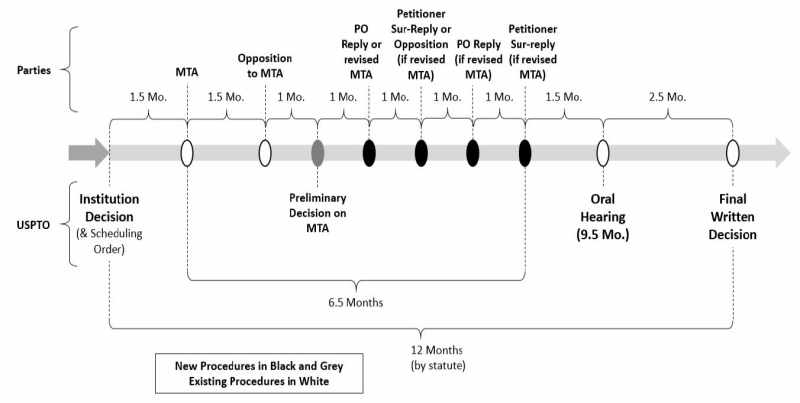Despite changing claim construction to district court standard, where BRI had always been premised on the patent owners ability to amend, it appears the USPTO is responding to a half-decade of negative comments from the patent owner bar.
The USPTO recently issued a proposed motion to amend (MTA) procedure requesting comments by December 14, 2018.
The proposed MTA procedure includes a preliminary non-binding decision from the PTAB discussing the merits of the motion. Patent owner can revise their motion at a later time based on the feedback received in the preliminary decision. The MTA procedure is to be resolved within 6.5 months.
The proposed timeline is:
- PO files initial motion to amend – 1.5 months after Institution
- Petition files opposition to MTA – 1.5 months after MTA
- PTAB preliminary decision (not binding on FWD, similar to institution) – 1 month after opposition.
- PO reply or revised MTA – 1 month after preliminary decision
- Petitioner sur-reply or opposition to revised MTA – 1 month
- PO reply to opposition to revised MTA – 1 month
- Petitioner sur-reply – 1 month

The proposed burden of persuasion is from Western Digital and is on the “petitioner to show that any proposed substitute claims are unpatentable.” In addition, the “Board itself may justify any finding of unpatentability by reference to evidence of record in the proceeding.”
The USPTO will implement this new procedure in a pilot program. However, that program will likely not begin until 2019, to provide the Board adequate time to consider all submitted comments.
This new motion to amend procedure is a concerted effort by the Board to provide patent owners a real opportunity to amend their claims during a PTAB trial, as required by 35 U.S.C §§ 316(d) and 326(d). In this regard, the procedure appears skewed in patent owner’s favor and is likely to cause serious headaches for petitioners, not to mention significant increased cost. In addition to the opportunity to amend, this increased trial complexity for petitioners could be another reason for patent owners to consider the motion to amend procedure, especially in the case of multiple co-pending PTAB trials involving related patents.
Will this lead to greater success for patent owner’s motion to amend and start to swing the FWD momentum to saving patents? Only time will tell.

Receive insights from the most respected practitioners of IP law, straight to your inbox.
Subscribe for Updates